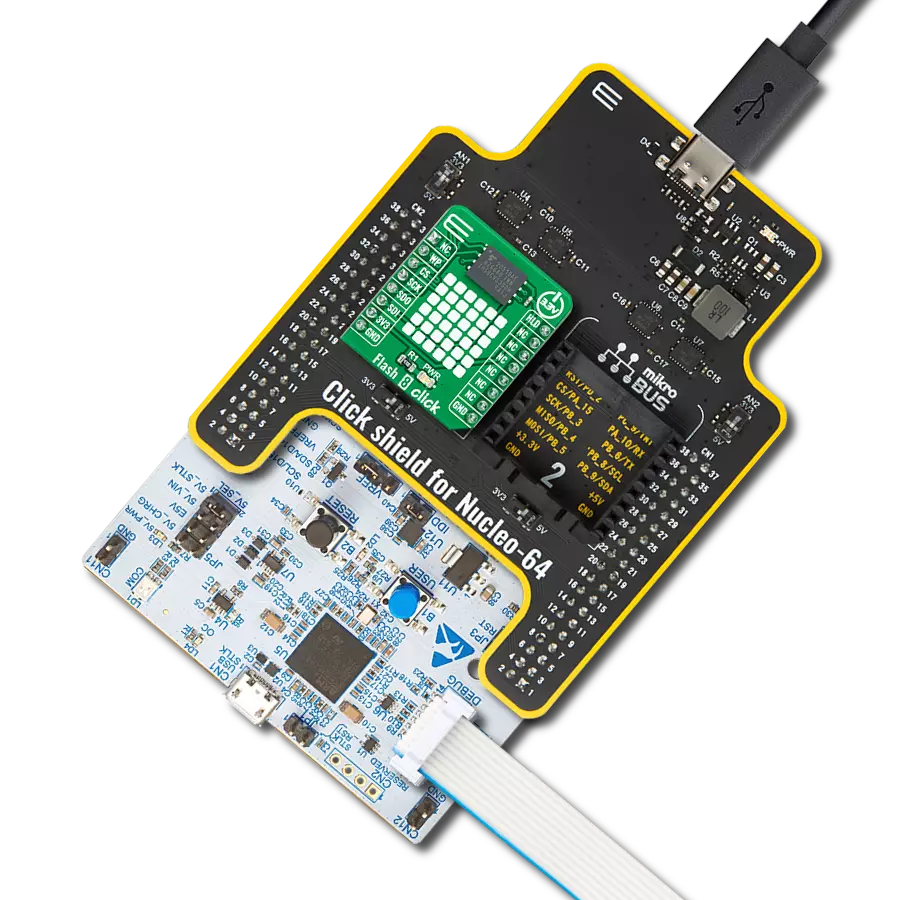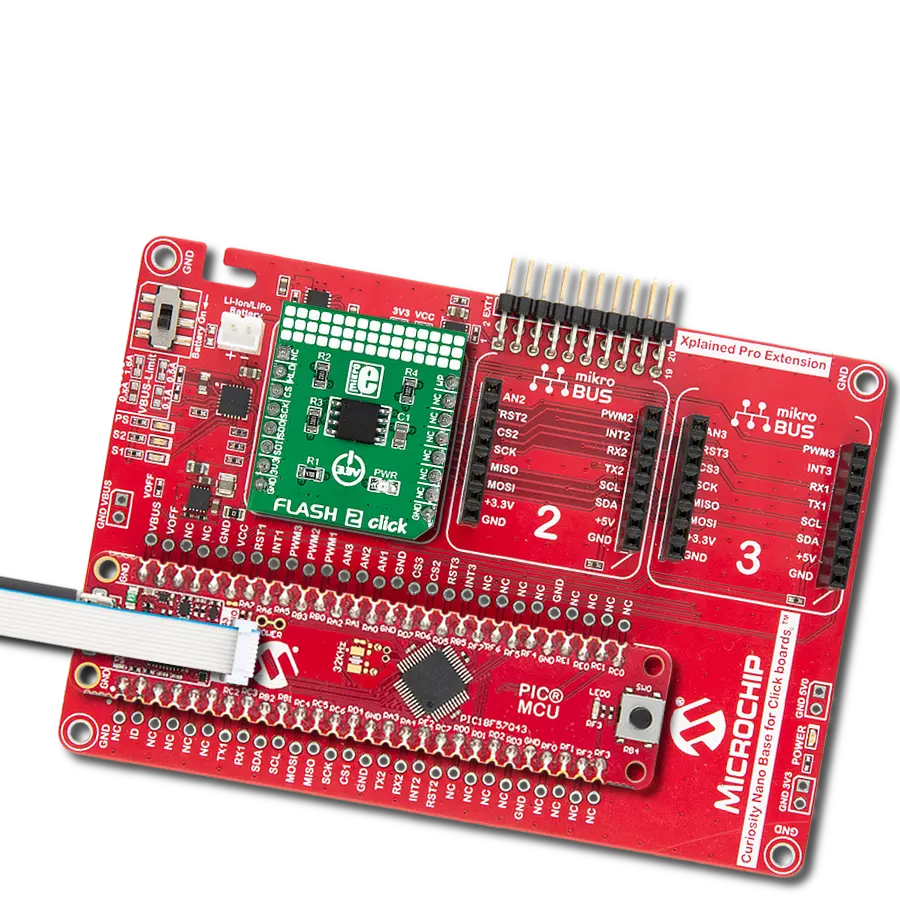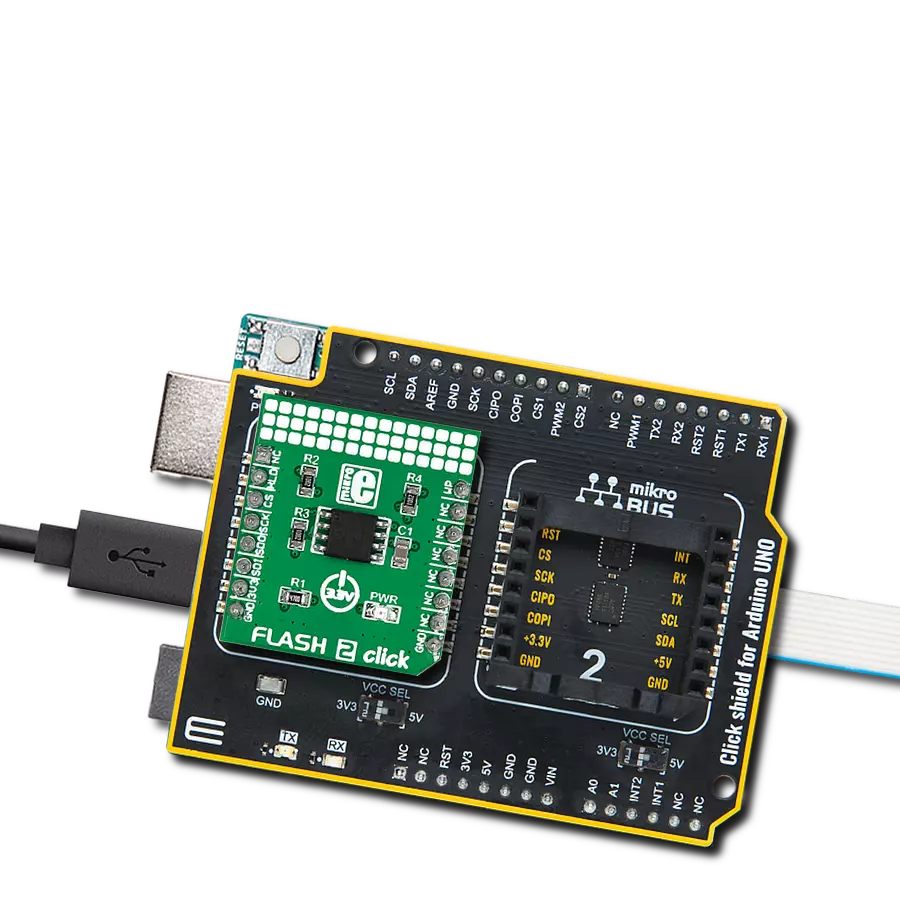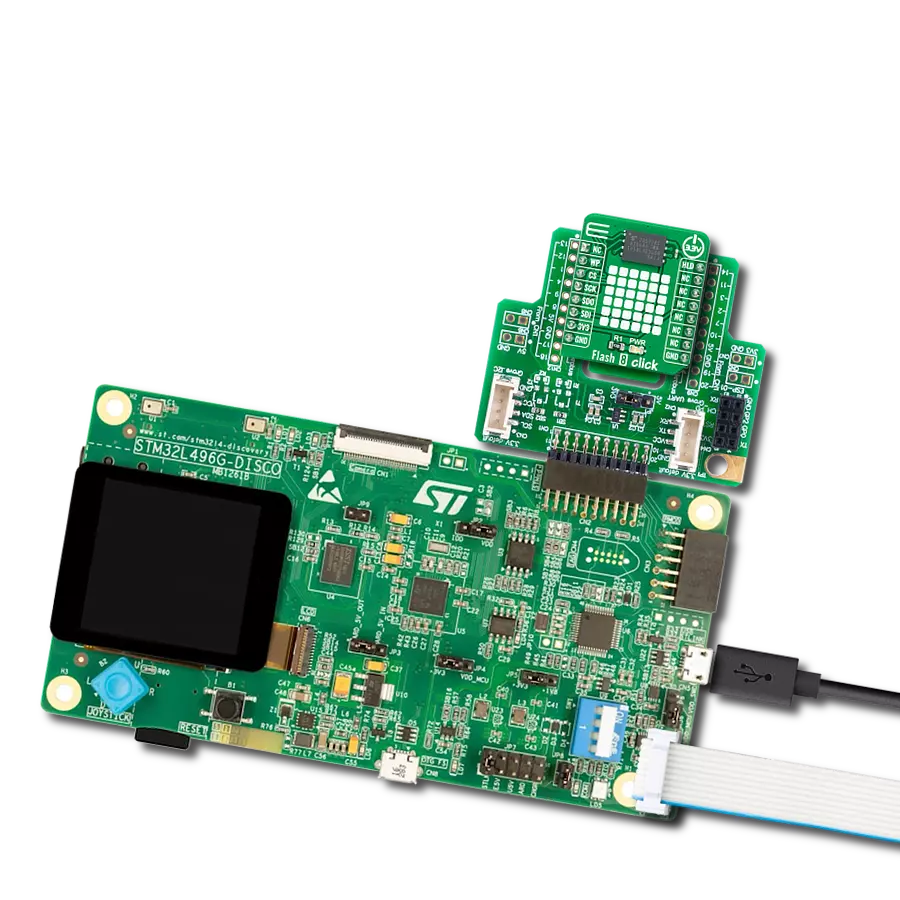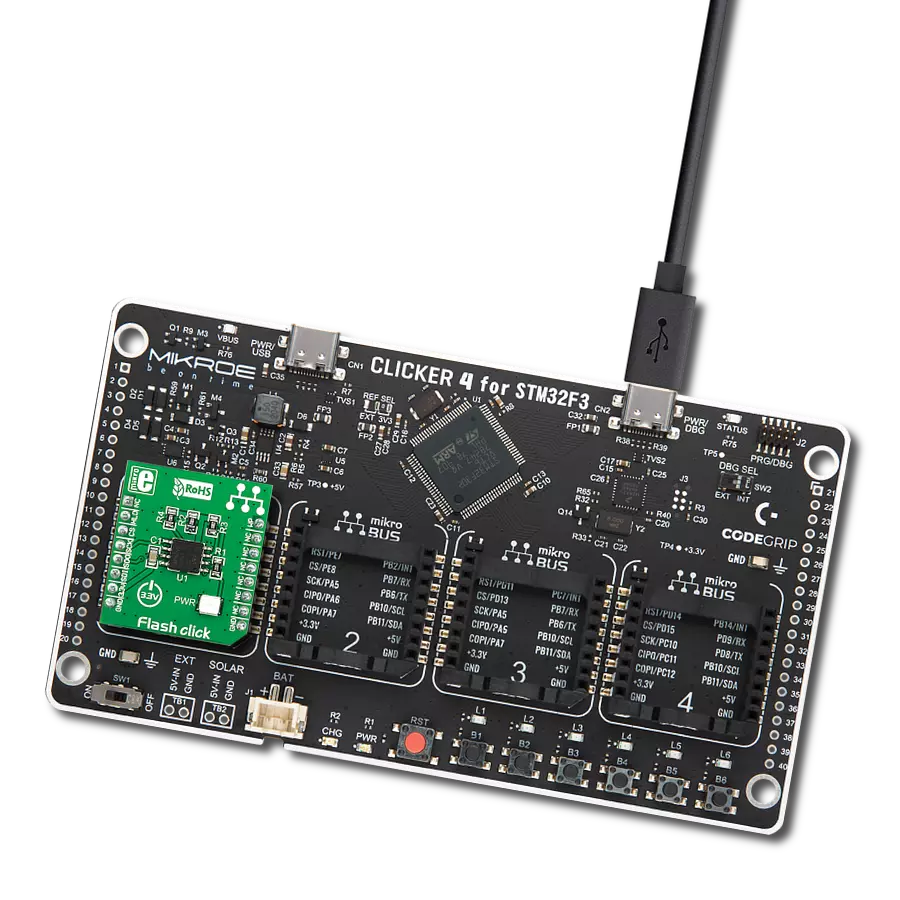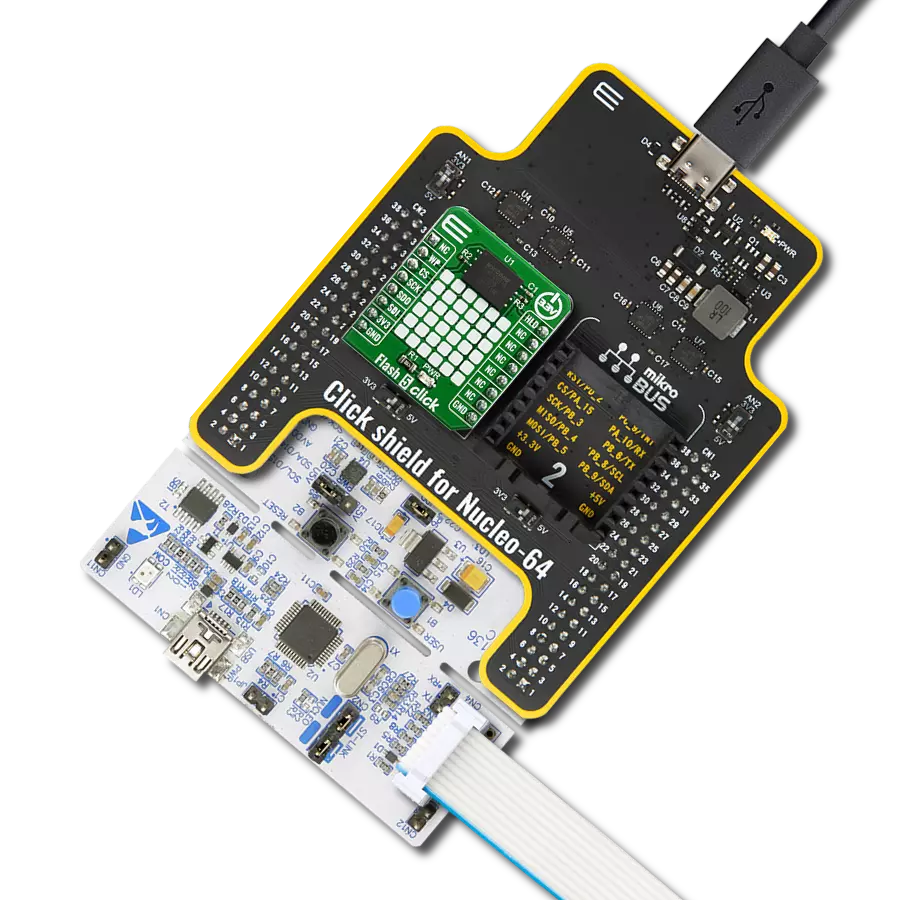Ensure reliable data retention and encryption through our flash memory solution
A
A
Hardware Overview
How does it work?
Flash 5 Click is based on the W25N01GVZEIG/IT (1G-bit) Serial SLC NAND Flash Memory from Winbond. The device operates on a single 3.3V power supply with current consumption as low as 25mA active and 10µA for standby. All W25N SpiFlash family devices are offered in space-saving packages, which were previously impossible to use for the typical NAND flash memory. The W25N01GVZEIG/IT 1G-bit memory array is organized into 65,536 programmable pages of 2,048 bytes each. The entire page can be programmed simultaneously using the data from the 2,048-Byte internal buffer. Pages can be erased in groups of 64 (128KB block erase). The W25N01GVZEIG/IT has 1,024 erasable blocks. The Flash 5 Click uses the standard Serial Peripheral Interface (SPI), supporting SPI clock frequencies of up to 104MHz. Besides that, the W25N01GVZEIG/IT provides a new Continuous Read Mode that allows for efficient access to the entire memory array with a single Read command. This feature is ideal
for code-shadowing applications. Also, it offers the highest performance thanks to the Serial NAND Flash with 104MHz Standard/Dual/Quad SPI clocks and a 50MB/S continuous data transfer rate. Given that it has an efficient “Continuous Read Mode,” it allows direct read access to the entire array. However, the performance depends on the main MCU used with this Click board™. A Hold pin, Write Protect pin and programmable write protection provide further control flexibility. Additionally, the device supports JEDEC standard manufacturer and device ID, one 2,048-Byte Unique ID page, one 2,048-Byte parameter page, and ten 2,048-Byte OTP pages. To provide better NAND flash memory manageability, user-configurable internal ECC and bad block management are also available in W25N01GVZEIG/IT. The W25N01GVZEIG/IT is accessed through an SPI-compatible bus consisting of four signals: Serial Clock (CLK), Chip Select (/CS), Serial Data Input (DI), and Serial Data
Output (DO). Standard SPI instructions use the DI input pin to serially write instructions, addresses, or data to the device on the rising edge of CLK. The DO output pin reads data or status from the device on the falling edge of CLK. For a detailed explanation, please consult the included datasheet. However, MikroElektronika provides a library that contains functions that simplify and speed up working with this device. The provided application example demonstrates the functionality of the library functions. It can be used as a reference for a custom project development. This Click board™ can be operated only with a 3.3V logic voltage level. The board must perform appropriate logic voltage level conversion before using MCUs with different logic levels. Also, it comes equipped with a library containing functions and an example code that can be used, as a reference, for further development.
Features overview
Development board
Nucleo 32 with STM32F031K6 MCU board provides an affordable and flexible platform for experimenting with STM32 microcontrollers in 32-pin packages. Featuring Arduino™ Nano connectivity, it allows easy expansion with specialized shields, while being mbed-enabled for seamless integration with online resources. The
board includes an on-board ST-LINK/V2-1 debugger/programmer, supporting USB reenumeration with three interfaces: Virtual Com port, mass storage, and debug port. It offers a flexible power supply through either USB VBUS or an external source. Additionally, it includes three LEDs (LD1 for USB communication, LD2 for power,
and LD3 as a user LED) and a reset push button. The STM32 Nucleo-32 board is supported by various Integrated Development Environments (IDEs) such as IAR™, Keil®, and GCC-based IDEs like AC6 SW4STM32, making it a versatile tool for developers.
Microcontroller Overview
MCU Card / MCU

Architecture
ARM Cortex-M0
MCU Memory (KB)
32
Silicon Vendor
STMicroelectronics
Pin count
32
RAM (Bytes)
4096
You complete me!
Accessories
Click Shield for Nucleo-32 is the perfect way to expand your development board's functionalities with STM32 Nucleo-32 pinout. The Click Shield for Nucleo-32 provides two mikroBUS™ sockets to add any functionality from our ever-growing range of Click boards™. We are fully stocked with everything, from sensors and WiFi transceivers to motor control and audio amplifiers. The Click Shield for Nucleo-32 is compatible with the STM32 Nucleo-32 board, providing an affordable and flexible way for users to try out new ideas and quickly create prototypes with any STM32 microcontrollers, choosing from the various combinations of performance, power consumption, and features. The STM32 Nucleo-32 boards do not require any separate probe as they integrate the ST-LINK/V2-1 debugger/programmer and come with the STM32 comprehensive software HAL library and various packaged software examples. This development platform provides users with an effortless and common way to combine the STM32 Nucleo-32 footprint compatible board with their favorite Click boards™ in their upcoming projects.
Used MCU Pins
mikroBUS™ mapper
Take a closer look
Click board™ Schematic

Step by step
Project assembly
Track your results in real time
Application Output
1. Application Output - In Debug mode, the 'Application Output' window enables real-time data monitoring, offering direct insight into execution results. Ensure proper data display by configuring the environment correctly using the provided tutorial.

2. UART Terminal - Use the UART Terminal to monitor data transmission via a USB to UART converter, allowing direct communication between the Click board™ and your development system. Configure the baud rate and other serial settings according to your project's requirements to ensure proper functionality. For step-by-step setup instructions, refer to the provided tutorial.

3. Plot Output - The Plot feature offers a powerful way to visualize real-time sensor data, enabling trend analysis, debugging, and comparison of multiple data points. To set it up correctly, follow the provided tutorial, which includes a step-by-step example of using the Plot feature to display Click board™ readings. To use the Plot feature in your code, use the function: plot(*insert_graph_name*, variable_name);. This is a general format, and it is up to the user to replace 'insert_graph_name' with the actual graph name and 'variable_name' with the parameter to be displayed.

Software Support
Library Description
This library contains API for Flash 5 Click driver.
Key functions:
flash5_page_read- Function for setting page readflash5_page_load_memory- Function for loading one pageflash5_write_status_data- Function for writing status data
Open Source
Code example
The complete application code and a ready-to-use project are available through the NECTO Studio Package Manager for direct installation in the NECTO Studio. The application code can also be found on the MIKROE GitHub account.
/*!
* \file
* \brief Flash5 Click example
*
* # Description
* This application is for storing mass storage.
*
* The demo application is composed of two sections :
*
* ## Application Init
* Initializes driver, resets device, erasing one page of memory, tests communication and configures device.
*
* ## Application Task
* Writes "MikroE" to device memory and then reads it and sends it to log.
*
* \author MikroE Team
*
*/
// ------------------------------------------------------------------- INCLUDES
#include "board.h"
#include "log.h"
#include "flash5.h"
// ------------------------------------------------------------------ VARIABLES
static flash5_t flash5;
static log_t logger;
static char write_buf[ 7 ] = { 'M', 'i', 'k', 'r', 'o', 'E', 0 };
// ------------------------------------------------------ APPLICATION FUNCTIONS
void application_init ( void )
{
log_cfg_t log_cfg;
flash5_cfg_t cfg;
uint8_t device_check = 0;
/**
* Logger initialization.
* Default baud rate: 115200
* Default log level: LOG_LEVEL_DEBUG
* @note If USB_UART_RX and USB_UART_TX
* are defined as HAL_PIN_NC, you will
* need to define them manually for log to work.
* See @b LOG_MAP_USB_UART macro definition for detailed explanation.
*/
LOG_MAP_USB_UART( log_cfg );
log_init( &logger, &log_cfg );
log_info( &logger, "---- Application Init ----" );
// Click initialization.
flash5_cfg_setup( &cfg );
FLASH5_MAP_MIKROBUS( cfg, MIKROBUS_1 );
flash5_init( &flash5, &cfg );
log_printf( &logger, " - Reseting device... \r\n" );
flash5_software_reset( &flash5 );
Delay_ms ( 1000 );
log_printf( &logger, " - Erasing memory... \r\n" );
flash5_send_cmd( &flash5, FLASH5_CMD_WRITE_ENABLE );
flash5_erase_page_data( &flash5, 0x0001 );
device_check = flash5_device_id_check( &flash5 );
if ( device_check == FLASH5_DEVICE_OK )
{
log_printf( &logger, " - Device OK \r\n" );
}
else
{
log_printf( &logger, " - Device Error \r\n" );
for( ; ; );
}
Delay_ms ( 100 );
log_printf( &logger, " - Configuring device \r\n" );
flash5_write_status_data( &flash5, FLASH5_CMD_WRITE_REG_STATUS1, FLASH5_REG_STATUS_1, FLASH5_RS1_WRITE_PROTECTION_DISABLE |
FLASH5_RS1_SRP1_ENABLE );
flash5_write_status_data( &flash5, FLASH5_CMD_WRITE_REG_STATUS1, FLASH5_REG_STATUS_1, FLASH5_RS2_PAGE_READ_MODE );
Delay_ms ( 1000 );
log_printf( &logger, "***** App init ***** \r\n" );
log_printf( &logger, "------------------- \r\n" );
Delay_ms ( 500 );
}
void application_task ( )
{
char read_buf[ 6 ];
uint8_t n_counter;
flash5_send_cmd( &flash5, FLASH5_CMD_WRITE_ENABLE );
flash5_page_load_memory( &flash5, 0x000A, &write_buf[ 0 ], 6 );
flash5_page_read_memory( &flash5, 0x000A, &read_buf[ 0 ], 6 );
for( n_counter = 0; n_counter < 6; n_counter++ )
{
log_printf( &logger, " %c ", read_buf[ n_counter ] );
Delay_ms ( 100 );
}
log_printf( &logger, " \r\n" );
log_printf( &logger, "------------------- \r\n" );
Delay_ms ( 1000 );
Delay_ms ( 1000 );
Delay_ms ( 1000 );
Delay_ms ( 1000 );
Delay_ms ( 1000 );
}
int main ( void )
{
/* Do not remove this line or clock might not be set correctly. */
#ifdef PREINIT_SUPPORTED
preinit();
#endif
application_init( );
for ( ; ; )
{
application_task( );
}
return 0;
}
// ------------------------------------------------------------------------ END
Additional Support
Resources
Category:FLASH




















